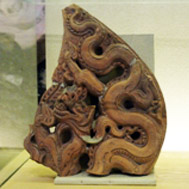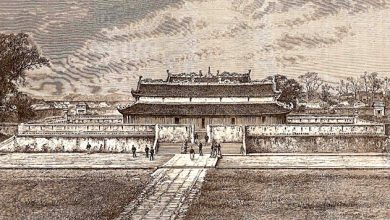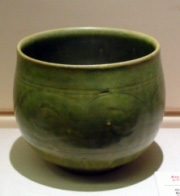Thang Long Imperial City under Tran Dynasty
The Imperial City under the Tran and Ly Dynasties was basically not much different. Inheriting the Ly Dynasty, the Tran Dynasty also divided the Imperial City into 61 wards, including trade, handicraft and agricultural wards. The royal family and mandarins also built palaces inside the Imperial City.
About the system of imperial palaces in the capital city, in 1237, King Tran Thai Tong moved Linh Quang Palace to Dong Bo Dau Port and renamed it as Feng Shui Palace. This was the place to welcome the king to see the boat race and the place to give tea and betel to the king. Therefore, the folk often called Ho Tra Palace. Dong Bo Dau Port was both a military port and a place to train naval military. It was the site to organize boat races in the fall annually. Thus, this port was built as an imposing architecture cluster. Hoai Vien Station of the Ly Dynasty was still used by the Tran Dynasty. Besides, the Tran Dynasty built another embassy dedicated to the Northern emissary in Quan Su area (it is still called Quan Su) and the royal step-over palace for the King in Gia Lam area today.
Following the tradition of respecting teachers and appreciating good deed, in 1243, King Tran Thai Tong renovated the Temple of Litterature. In 1253, King Tran Thai Tong set the Temple of Litterature as a place for educating the children of the aristocracy and elites of the country. At the same time, he ordered to renovate the statues of Confucius, Chu Cong and 72 Confucianists to worship here. The temples, pagodas and shrines under the Tran Dynasty were virtually not newly built but restored available architecture from the Ly Dynasty. This shows that to the Tran Dynasty, Confucianism was more respected by the court. Buddhism was still prevalent, but no longer held the supreme position as under the Ly Dynasty.
To promote martial art spirit, in 1253, Tran Thai Tong built Giang Vo Building as a place to practice martial arts. All the princes had to undergo martial arts training there.
Besides the imperial palaces and buildings of the mandarins, the Imperial Citadel also included the trade, handicraft and agriculture wards. For the first time, the official historical documents recorded about the number of wards in Thang Long. The old history recorded that “Mimick the previous dynasty, divide the country into 61 wards”. With this data, it is possible to confirm that the division of Thang Long into 61 wards existed from the Ly Dynasty.
According to old historical documents, some of ancient wards under the Tran Dynasty are as follows:
An Hoa Ward was located on the bank of Cai River (Red River) where the coffin of King Ly Hue Tong was cremated. According to the historical documents, although the Tran Dynasty replaced the Ly Dynasty to rule the country, Ly Hue Tong was forced to become a monk but he still concerned about the national affairs and often strolled in the wards and markets. Thus, a great many of people gathered to see him. Tran Thu Do was afraid that upheavals could happen so he sent people to kill Ly Hue Tong, cut a path through the citadel and cremated the coffin of Ly Hue Tong in An Hoa Ward. The event took place in the fall of 1226.
Hac Kieu Ward was the place where Phu Thien Palace was situated. Phu Thien Palace was the residence of Tran Thai Tong’s father, who was ordained Thái Thượng Hoàng (Father of the King) in October 1226 in accordance with the lunar calendar.
Giang Khau Ward was the place to detain Hon Duc Cong Duong Nhat Le who attempted to usurp the throne of the Tran Dynasty in 1370.
Co Xa Ward was a port and was home to the residents in the alluvial land. In 1265, the water flooded the entire ward, drowning many residents and animals. For this reason, King Tran Thanh Tong issued the general amnesty to reduce the disaster.
Phung Thien District had the following wards: Tang Kiem specialized in producing palanquin, armors and weapons; Yen Thai specialized in making paper; Thuy Chuong and Nghi Tam specialized in fabric and silk weaving; Ha Tan concentrated with lime workers; Hang Dao specialized in dyeing; Ta Quat in producing fans; Thinh Quang in producing longane fruit; Dong Nhan selling dresses.
In the west of the Imperial City, there were Tay Nhai Ward (now part of Lieu Giai area) and Kieu Cac Dai Ward.
Nhai Tuan Ward was the place for the people of Song Dynasty who exiled to Dai Viet since Yuan Dynasty invaded China. The King also enable these people to do business. When Kublai claimed the Tran Dynasty to hand over these people, King Tran Thai Tong bluntly rejected.
In the North of To Lich River, Toan Vien (Garlic Garden) Ward was the place where King Tran Du Tong ordered to grow garlics and vegetables. This ward was located near to Cua Bac (North Gate), across Phan Dinh Phung Street (formerly To Lich River flew through).





